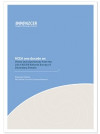This report documents views and experiences of NCEA from NZCER's 2012 National Survey of Secondary Schools. Responses from teachers (1266) and principals (177) predominate, but the report also reflects the responses from parents (1477) and trustees (289). Full details of the sample are in the overview report, Secondary schools in 2012.
This report shows support for NCEA has remained high among principals and consolidated among teachers, school trustees and parents. Schools have generally welcomed the recent changes to NCEA such as endorsement of whole courses with merit or excellence and the increased support provided by best practice workshops for teachers. However the high teacher workload associated with NCEA remains unresolved.
The survey also covers views about whether NCEA is driving the curriculum and responses to the Government’s recently announced policy target that by 2017, 85 percent of students should gain an NCEA Level 2 qualification or its equivalent.
Methodology
Four groups are surveyed in each round, with contact and sampling procedures tailored to the practical challenges of reaching a representative number of respondents from each group. In 2012:
- all secondary principals of state and state-integrated schools were surveyed via a posted questionnaire
- all teachers on the PPTA’s email database were surveyed via a web-based questionnaire
- the board chair and one other member of each school’s board of trustees were surveyed via posted questionnaires sent to the board chair
- a random sample of parents from a representative sub-sample of secondary schools were surveyed with the help of these schools.
The details of the sample actually achieved are outlined in the overview report of the key findings from the 2012 NZCER National Survey (Wylie, 2013). Responses were broadly representative for all four groups. The survey took place during the third school term of 2012.
Because each survey includes a range of questions on different themes, it is possible to look for relationships across these themes; for example, to see whether teachers’ views of NCEA are related to their reports of their workload or their views of NZC. We used crosstabulation and factor analysis to explore such relationships.
Because the survey is completed by a large number of respondents, it is also possible to look for patterns in responses related to variables of interest (e.g., school decile). Other teacher variables investigated included: role in school, main teaching subject, gender, number of years of teaching, and overall morale. Other principal variables investigated included: the percentage of Māori students on the school roll, the percentage of Pasifika students on the school roll, roll size of the school, and the principal’s overall morale.
The chi-square test was used to identify statistically significant differences related to these characteristics.

